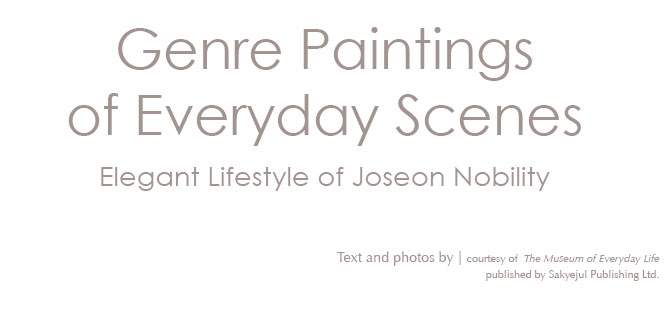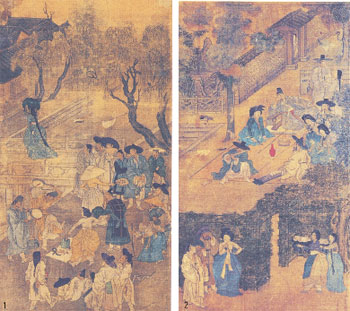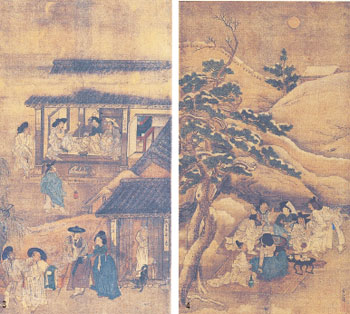 |
A Brush with Lively Touch |
 |
 |
 |
 |
 |
 |
Paintings of local landscapes and daily scenes from Koreans' lives became popular in the latter part of the Joseon Dynasty (1392-1910), when painters more often depicted the realistic scenes of their surroundings, departing from influences of Chinese art. Genre paintings, presenting the down-to-earth realities of Korean folk life, constituted
an important phase of this novel movement
which gave birth to a truly Korean school of art.
Yun Du-seo (1668-1715) and Jo Yeong-seok

|
 |
(1686-1761) were among amateur painters of the yangban noble class who first ventured into the new genre. Then, in the late 18th century, professional artists of the Academy of Painting, such as Kim Hong-do (1745-1815?), Sin Yun-bok (1758-?) and Kim Deuk-sin (1604-1684), actively engaged in depicting daily scenes around them.
These artists focused on prominent social issues of their era, such as conflict among social classes, love affairs involving gisaeng courtesans, corruption
of Buddhist monks and the drinking culture. Their paintings, in a sense, performed the role of critical media like newspapers nowadays. What is interesting is that their paintings did not simply describe controversial scenes but presented them with uniquely positive attitudes toward life and a brimming sense of humor and satire. The human figures in the paintings are far from looking despondent, despite their hard life.
The four paintings introduced here are from an eight-panel screen believed to be the work of Kim Hong-do. The screen was purchased by a Frenchman named Louis Marin during his short visit to Seoul in 1901 and donated to the Guimet Museum in Paris by his family in 1962 after his death. It is signed "Kim Hong-do" in standard Chinese script near the bottom. Not only the autograph but the brushwork closely resembles those of Kim' s other works.
|
Vagabond Clowns' Show1):
Streamside Performance Entices Everyone
Traveling clowns, called sadangpae, are putting
on a show alongside a stream, attracting an interesting assortment of spectators. The audience
drawn by the exciting sound of drums includes
a young nobleman hiding his face with a fan, a boy on his way to village school holding a book under his arm and an old woman carrying
her grandchild on her back. A smart female clown collects coins while young men steal a glance at a maid hurrying her way to run an errand. In the late Joseon period the wandering clowns were popular entertainers presenting a varied repertoire of mask dances, the pansori epic chants, the ssireum wrestling and even shaman rites.
Party in the Rear Garden2):
Host Looks Gloomy Though Music Plays
A party is under way in the rear garden of a classy nobleman' s mansion. Beautiful gisaeng attend to the guests and musicians play their instruments
as cranes and mandarin ducks roam around the pond. While everyone around seems to be enjoying the mood, the host is the only person immersed in some gloomy thoughts. The yangban aristocrats of Joseon threw parties
at home inviting musicians and dancers. Among the wealthy literati class in the capital it was a fad to own villas in the scenic suburbs as well as luxurious mansions in the city. They enjoyed an elite culture, demonstrating refined tastes by furnishing their homes with tens of thousands of books and numerous antiques, paintings and calligraphy works.
A Scene at Courtesan House 3):
Losers Leave While Winners Stay
Fist fights among clients were a daily scene at many courtesan houses, which were a kind of exclusive clubs run with picky regulations. All types of womanizers, including not a few roughnecks, frequented those establishments and naturally, physical confrontations among them were frequent. As suggested in this painting
|
 |

depicting a scene following such a scuffle, the winners occupy the place for the night while the losers leave in humiliation. The man holding a square lantern has yet to overcome his emotion. He is being dragged out by a colleague.
Those in the house seem self-content like triumphant conquerors. They couldn' t care less about what goes on outside the gate.
Barbecue in the Snow 4):
Tasty Treat on a Moonlit Night
A group of men and women are enjoying a barbecue
under the full moon. The snow on the pine branches and the fur hats worn by some of the figures denote it' s a winter night. There is a latecomer; the man is so impatient that he is getting on the mat without taking off his leather shoes. In 18th century Joseon there was a popular old custom to have beef barbecues during the lunar tenth month, probably to get stamina to fight cold spell during the winter. The Seasonal Customs of Korea (Dongguk sesi gi), written in 1849, says that "in Hanyang (present-day Seoul) they sit around a charcoal fire and eat beef roasted on a grill after seasoning
with soy sauce, oil, egg, scallion, garlic and red pepper powder."
|
|
 |


